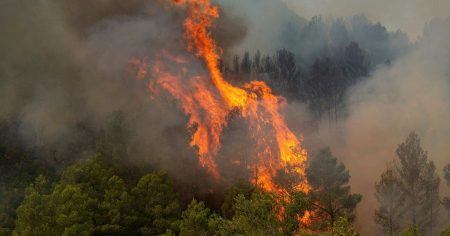The world has witnessed a surge in extreme weather events in recent years, a trend starkly highlighted by Spain’s recent devastating wildfires. These events, occurring merely weeks after similar catastrophes ravaged other continents, raise profound questions about the changing state of our planet and the role of human activity in these escalating natural disasters. Spain’s fires, fueled by intense heatwaves and prolonged drought, underscore a global pattern of increasingly frequent and severe wildfires, from the Amazon rainforest to the Australian bush, painting a grim picture of a world grappling with the consequences of a warming climate. Understanding the forces driving these events requires a deep dive into the science of climate change, the complex interplay of natural variability and human influence, and the far-reaching implications for ecosystems, societies, and the future of our planet.
The Earth’s climate is a dynamic system influenced by a myriad of factors, including solar radiation, atmospheric composition, ocean currents, and volcanic activity. Natural climate variability has always played a role, producing fluctuations in temperature and precipitation patterns over time. However, the overwhelming scientific consensus points to human activities, particularly the burning of fossil fuels, as the primary driver of the observed warming trend over the past century. The release of greenhouse gases, such as carbon dioxide and methane, traps heat in the atmosphere, leading to a gradual increase in global average temperatures. This warming trend has cascading effects, amplifying existing weather patterns and increasing the likelihood and intensity of extreme events like heatwaves, droughts, floods, and wildfires.
The link between climate change and wildfires is particularly pronounced. Rising temperatures accelerate evaporation, drying out vegetation and creating tinderbox conditions. Prolonged droughts further exacerbate this dryness, increasing the risk and severity of wildfires. Warmer temperatures also contribute to longer fire seasons, expanding the window of opportunity for ignition and spread. Moreover, climate change can alter wind patterns, leading to stronger and more erratic winds that can fan flames and carry embers over long distances, further accelerating fire spread and making containment efforts more challenging. The resulting devastation not only destroys ecosystems and property but also releases vast amounts of carbon dioxide into the atmosphere, creating a dangerous feedback loop that accelerates climate change.
The consequences of these extreme weather events extend far beyond immediate destruction. Intensified wildfires pose significant risks to human health, releasing harmful pollutants into the air and exacerbating respiratory illnesses. The loss of vegetation and soil erosion can lead to landslides and mudslides, further endangering lives and infrastructure. Droughts and floods can disrupt agricultural production, leading to food shortages and economic instability. Furthermore, the displacement of communities due to extreme weather events can create humanitarian crises, putting strain on resources and social structures.
Addressing the escalating threat of extreme weather events requires a multifaceted approach that combines mitigation and adaptation strategies. Mitigation efforts focus on reducing greenhouse gas emissions to slow down the pace of climate change. This includes transitioning to renewable energy sources, improving energy efficiency, and promoting sustainable land management practices. Adaptation strategies focus on building resilience to the impacts of climate change that are already occurring and projected to worsen in the future. This involves developing early warning systems for extreme weather events, strengthening infrastructure to withstand climate impacts, and implementing measures to protect vulnerable populations.
International cooperation is essential to address the global challenge of climate change effectively. The Paris Agreement, a landmark international accord, aims to limit global warming to well below 2 degrees Celsius above pre-industrial levels, with efforts to limit the increase to 1.5 degrees Celsius. Achieving these ambitious goals requires concerted efforts from all countries to reduce emissions and invest in adaptation measures. Furthermore, international collaboration on research and technology development can accelerate the deployment of clean energy solutions and enhance our understanding of climate change impacts. Ultimately, addressing the escalating threat of extreme weather events requires a fundamental shift in our relationship with the planet, embracing sustainable practices and recognizing the interconnectedness of human actions and environmental consequences. The recent events in Spain, a stark reminder of the growing threat of climate change, underscore the urgency of action to protect our planet and future generations.














